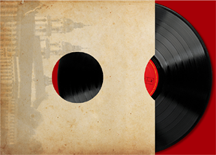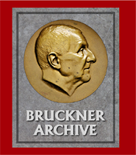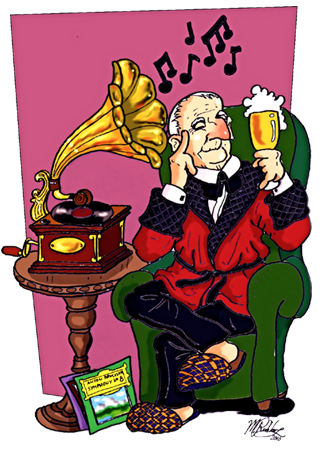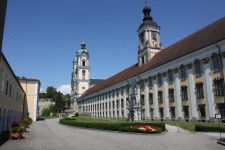Travel Report - Austria / Germany - 2011
I will not go into the mundane aspects of my travel except for two points. First, by being invited to stay at the Guest House (Gastehaus) at St Florian, It has allowed me to understand the special place that this is, but the one sacrifice is the loss of Internet. Bruckner came back to Saint Florian several times in his life for spiritual rejuvenation. It is that type of place. Nothing is hurried, the modern world is shut out and one is left to reflect. Upon entering Saint Florian, It is clear that this is one of its priorities. There are no radios or televisions in the rooms, nor is there Internet. So my reports are being written on my computer, and will be submitted as soon as a connection can be found. Secondly, I would recommend to anyone travelling by car in Europe to update whatever GPS system they have at home and use it for your travels. I decided to do this at the last minute and it worked perfectly (usually…). It let me work with a system that I was familiar with and it allowed me to avoid the highways where there is very little to see. I drove through numerous small villages in Germany and Austria and got a much better feeling for this part of Europe, which, in many ways, has not changed much since Bruckner was here. After leaving Munich, my first stop was Ansfelden. With the weather forecast for Thursday not being very good, I decided to take the opportunity to get some good photos of Bruckner’s birth house (Geburthaus) while the sun was out, While there, I ran in to my Linz tour guide, Mr. Adolf Riegler who was scheduled to give me a special tour of the birth house and Ansfelden sites and then a tour of Linz the following day. We agreed to meet again early the next morning. Then I was off to Saint Florian which is just a few miles away via a very rural, narrow road that traverses rolling farmland and woods. The Abbey of Saint Florian is certainly the commanding structure in this small town. The abbey itself was built in 1750 but churches on this site date back to the 11th century. Some of the existing structure dates back to 1200 and part of that foundation is still visible below ground. When I arrived, I was able to sit in on an organ recital by Klaus Sonnleitner performing on the Bruckner Organ. The recital included a performance of Erwin Horn’s "Kaiserlichte Festmusik," which concludes with a rousing transcription of the Finale to Bruckner’s Symphony No, 1. It was a fitting welcome. After settling into my room, I went to meet with Klaus Laczika, one of the guiding lights behind the BrucknerTage Festival . Joining Herr Laczika were members of the BrucknerTage Committee. I was escorted back to the Abbey Church and up to the organ loft for a private recital given by Matthias Giesen. He played for me and the BrucknerTage Committee a transcription of the Adagio from Bruckner’s String Quintet. The performance illustrated the potential symphonic power of this music and the glorious sound of the Bruckner Organ. After that, Mr. Giesen performed an improvisation that once again filled the church with Brucknerian sonorities. Following that wonderful recital, I was led down from the upper levels of the church to the crypt below. It is here that one can see some of the original foundations. As we worked our way to the front of the church, we passed by the coffins of past church leaders, some dating back hundreds of years. At the front of the church, we entered into a large room which contains Bruckner’s sarcophagus. The room also holds thousands of bones from remains unearthed during the expansion of the Abbey. As the last part of the tour, I was taken to a room where the furnishings from Bruckner’s room are on display. These include his Bosendorfer piano, his bed, and leather chair. It was now down to the Abbey’s restaurant where we sampled local brews and enjoyed a wonderful dinner in the open courtyard. We had a lively conversation that included news about upcoming BrucknerTage events. The conversation was occasionally punctuated by the ringing of the Abbey’s bells. Day 2 – July 28th: It was a busy day. After an early breakfast, I drove back to Ansfelden to meet my guide, Mr. Reisler, who was kindly furnished to me by the Linz Tourist Board. Bruckner’s Birth House is not usually open on weekdays, but special arrangements can be made. The museum is nicely planned in that the two front rooms are decorated in much the same way that they would have been during Bruckner’s lifetime. Bruckner’s father was the town’s school teacher and the front right room is set up as a typical one-room schoolhouse. The left room is arranged as the family’s living room but very sparsely furnished. The birth room holds the original console of the Bruckner Organ at St. Florian. The upstairs rooms are set up to describe Bruckner’s life. The museum contains the famous bust made by Victor Tilgner, Bruckner’s death mask and the clavichord that Bruckner used when he was assigned as schoolmaster in Windhaag. After the tour of the Birth House, we headed to Linz where I was taken to the Old Cathedral (Alter Dom), the Parish Church, (Stadt Pfarrkirche) and the New Cathedral (Marien Dom) The Alter Dom contains the organ that was used by Bruckner when he became the cathedral organist. Bruckner supervised the restoration of the organ and today, it sounds much like it did during his tenure from 1855 – 1868. The Mariendom was the site of the premiere of the e minor Mass. At the time, only part of the cathedral was completed. In one the stained glass window panes; there is a depiction of Bruckner and Beethoven. Bruckner was very active as a choir director and teacher while he was in Linz, and there are many buildings in the city where he worked with these ensembles. The tour concluded with a visit to the Brucknerhaus concert hall. Next, it was time to meet with representatives from the Linz Tourist Board to develop some cooperative activities. Their new Bruckner/Linz tourism brochure has just been published and there was some discussion of some future tours coordinated through this website. After these discussions, I headed to the Alter Dom to listen in on the rehearsal of the evening’s organ concert. After the rehearsal, I met with organist, Bernard Prammer. He allowed me to view the new “Brucknerstiege” (Bruckner stairs) exhibit which was just installed a few months ago. The exhibit, usually open to the public immediately following an organ concert, is an excellent series of displays set on the stairs to the organ loft. Listening sets in several languages are available as one works their way to the organ. It was prepared by Mr. Prammer, Elisabeth Maier and Renata Grasberger. Next, it was time to meet Dino Segui and Gerhard Hofer who are in the process of performing a cycle of Bruckner symphonies as arranged for piano four-hands. The performances are given each year on the piano located in the Alter Dom. The first two symphonies have been released on my abruckner.com label. These are fascinating performances because this is the way most people got to know Bruckner’s music during his lifetime, since orchestral performances of his symphonies were so rare. Mr Sequi and Mr. Hofer presented me with a copy of their performance of the Symphony No. 3 which will be released on my label soon. After some coffee and a nice conversation, we returned to the Alter Dom for the evening concert. Mr. Prammer’s concert was the second in this season’s series of organ recitals given at the Alten Dom. While Bruckner’s organ compositions were not presented, the concert revolved around Bruckner’s music in that many of the works incorporated Brucknerian themes within them. The evening ended with a drive back to St. Florian. My trusty GPS had some difficulty with satellite pickups and it spun me through the streets of Linz for a few minutes before settling down to the business at hand. It then toyed with me by sending me on some of the narrowest windy and darkest roads I have ever driven. I was certain that it was going to lead me into a dead end in the middle of the Austrian countryside. But just as I was giving up hope, it deposited me neatly at the front gate of the Augustinian abbey. One of the complications in Austria is that one must have a purchased windshield sticker to use the Autobahn. Since my car was rented in Germany, it does not have the sticker and the Autobahn must be carefully avoided. Day 3 – July 29th: Since the following event took place at midnight, it belongs as part of day three. My room in the Gastehaus at St. Florian is right next to the front of the church. Two doors down from my room is a door that leads into the crypt. As I was repacking my clothes for my departure, I realized that I had left something in my rented car, so I went out into the courtyard where the restaurant is located to return to my car. It is clear to me that I am the only person staying in the guest house at this time. When I go for breakfast in the restaurant each morning, there is only one place setting. At night, the Abbey is essentially deserted. While I was walking through this courtyard, I noticed that the twin church towers were illuminated. It was a beautiful sight, so I decided that when I went back to my room I would grab my camera and take a picture. As I left my room, the church bells began to ring. “A nice touch,” I thought. I should add that all the lights to my room are on timers. They are either motion sensitive or one switches them on and they switch off a few minutes later. As I left my room, I decided to go out into the courtyard that is directly opposite from the guest rooms. I walked out onto the gravel pathway and continued out to the center of the garden. As I reached the location where I wanted to take the picture, the lights on the church towers suddenly went out. A second or two later, the lights in my hallway went out. It was midnight. It was dark – very dark and I was alone – very alone. I moved very slowly in the direction that I had come from and, as my eyes adjusted to the darkness, I was able to find the courtyard door. Once in the corridor, I was able to turn on the lights. As I went to bed, I realized that my room was situated about forty feet from Bruckner’s sarcophagus. I was alone again, or was i?... After breakfast, I left St. Florian with my next destination being Ebrach, Germany – about a five hour drive to the northwest. Much of the drive followed the Danube which made for a scenic trip. I stopped in Regensburg – about half way – to visit the Valhalla, the shrine to German artists that overlooks the Danube. Valhalla holds a special place in the public recognition of Anton Bruckner. It was at this site on June 6, 1937 that Joseph Goebbels gave his famous speech which cleverly linked Bruckner, an Austrian musician to the ideals of German art and the National Socialist agenda. The speech coincided with the installation of Bruckner’s bust at Valhalla. There is a famous photograph of Hitler standing before the bust which sits atop a pedestal adorned with the Swastika. I located the bust in the right rear quadrant of the temple building (Bruckner now rests on a shelf next o Max Reger). The pedestal is gone and I spent some time determining the exact location where Hitler was standing when the 1937 photograph was taken. Due to the symmetry of the building, he was either standing in the right rear quadrant (where the bust is presently located, or in the front left quadrant. I suspect it was in the front left quadrant since that would place it near the entrance. I will research this later. After leaving Regensburg, I returned to the autobahn and continued my journey to Ebrach. The town is a bit of a mystery because it far off the beaten path with very narrow roads cutting through extensive farmland and yet there is this huge cloister in the center of town that will be the site of the Ebrach Summer Festival. The Bruckner Festival segment of the Summer Festival began with a reception in the Kaiser Hall in the cloister. This was followed by some lectures in German and the opening concert was given in the main church at 7PM. The very well attended concert featured the Bruckner Symphony No. 1 in c minor in the Linz version of 1866. This is a special version of the symphony which is usually heard in the version of 1877. The 1866 version (recorded only by Georg Tintner for his Naxos cycle) is the version first heard by Linz audiences. Gerd Schaller and the Festiva Philharmonie gave an extraordinary performance which was recorded by the Bavarian Radio for delayed broadcast. After the concert, many of the attendees gathered at a nearby restaurant to celebrate. I was part of a gang of Bruckner "Groupees," which included Ken Ward and Stephen Pearsall from the UK, Joachim Neusser, Dietmar Achenbach (and his wife, Lilo) and Dirk Borth (and his wife Pia Molck-Ude) from Germany and Werner de Smet from Belgium. In varying combinations, this group spent a good deal of time around the festival activities, William Carragan, Gerd Schaller and food and beer. Day 4 – July 30th: There were symposium talks this morning, but since they were in German, many of us chose not to attend. We were in need of some audio/camera cables, so Dietmar Aechenbach and his wife, Stephen Pearsall and I took a side trip to Bamberg, about 35 kilometers away. We spent time in the market square near the Old Town Hall and stopped at the Cathedral where an organ concert was presented. The second concert in the Bruckner series was given at 5PM. It was a performance of the Symphony No. 2 in the version of 1872 as edited by William Carragan. Bavarian Radio, Studio Franken was again on site. Earlier in the day, they closed the main road in town so that the rehearsals could be recorded without traffic noises. The concert performance was excellent and it appeared that the concert was sold out. Several of us marveled at this. How does one fill a huge church when (1) the only work on the concert is a Bruckner symphony and (2) the church is located in such a small and isolated community? Once again, we gathered after the concert for dinner with great German beer and wine and a lively discussion which ranged from Bruckner, to the debt ceiling debate in the US and on to topics far and wide. Day 5 – July 31st: It is the final day of the festival. Some of us learned that a full rehearsal was taking place at around 10AM, so a bunch of us (Dietmar Achenbach, Stephen Pearsall and Ken Ward) went down to the cloister and listened from the outside. We had a preview of the premiere later in the day. After the rehearsal was over, we meet with William Carragan and several of the symposium speakers for a luncheon. After the extended lunch, there was just a bit of time before the concert. The Bruckner Symphony No. 3 presented at this concert reflected the status of the score in 1874. Since there are already published editions of 1873, 1877 and 1889/90, this variant was performed, not to lay claim to yet another edition, but to provide a glimpse into Bruckner’s creative process. It also allowed listeners to hear some Brucknerian scoring that has not been heard before. As with the previous two performances The Philharmonie Festiva (made up of members of the Munich Philharmonic, the Bavarian Radio Symphony Orchestra and the Munich Bach Soloists) performed superbly and Gerd Schaller once again exhibited his ability to convey a committed performance in a very large acoustical space. As this was the last concert, some of us were invited to attend a reception presented by the burgomaster of Ebrach. It was a memorable festival! Day 6 – August 1st: This day was devoted to travel. I was up at 5:30AM and departed the hotel via rental car and drove the three hours from Ebrach to Munich Airport. Then US Airways to Philadelphia with a connecting flight to Hartford. Due to flight cancellations caused by thunder storms, it took me 23 hours to complete my journey home. |







